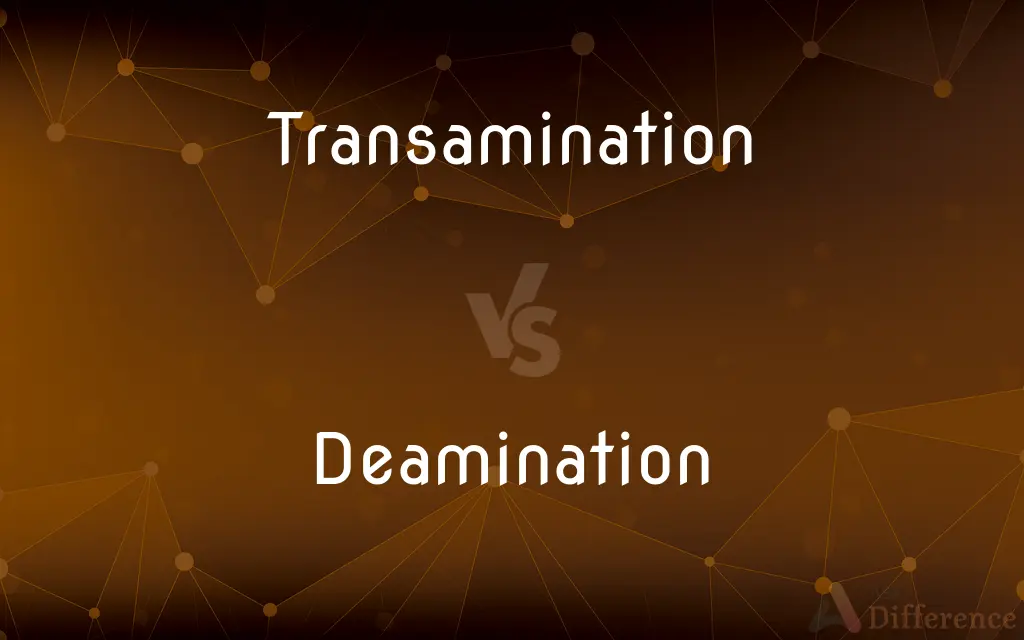Transamination vs. Deamination — What's the Difference?
By Fiza Rafique & Maham Liaqat — Updated on March 21, 2024
Transamination involves the transfer of an amino group from one amino acid to a keto acid, while deamination is the removal of an amino group from an amino acid, converting it into a keto acid and ammonia.

Difference Between Transamination and Deamination
Table of Contents
ADVERTISEMENT
Key Differences
Transamination is a biochemical process essential for the synthesis of non-essential amino acids within the body. It involves the enzymatic transfer of an amino group (NH2) from an amino acid (donor) to a keto acid (acceptor), resulting in the formation of a new amino acid and a new keto acid. On the other hand, deamination is the process by which an amino group is removed from an amino acid, producing a keto acid and ammonia (NH3). This reaction is vital for the removal of excess amino acids and their nitrogen in the body, facilitating nitrogen excretion primarily through the urea cycle.
While both processes are integral to amino acid metabolism, transamination facilitates the reuse of amino groups in synthesizing new amino acids, promoting the dynamic balance of amino acids in the body. In contrast, deamination is more about nitrogen waste management, converting excess amino acids into forms that can be safely excreted or used for energy production.
Transamination is critical for maintaining the amino acid pool and adapting to the body's nutritional and metabolic needs, allowing for the synthesis of non-essential amino acids and the metabolism of amino acids for energy. Deamination, however, is essential for the regulation of nitrogen levels in the body and the prevention of ammonia toxicity, playing a key role in the metabolic pathway that converts nitrogen from amino acids into urea.
In summary, while transamination is a reversible process that conserves amino groups for the synthesis of new amino acids, deamination is an irreversible process focused on the elimination of excess nitrogen through the formation of keto acids and ammonia, highlighting their distinct roles in amino acid and nitrogen metabolism.
Comparison Chart
Process
Transfer of an amino group from an amino acid to a keto acid.
Removal of an amino group from an amino acid.
ADVERTISEMENT
Resulting Products
A new amino acid and a new keto acid.
A keto acid and ammonia.
Enzymes Involved
Transaminases or aminotransferases.
Various, including dehydrogenases and hydrolases.
Cofactor Required
Pyridoxal phosphate (vitamin B6).
Varies, not always required.
Role in Metabolism
Synthesis of non-essential amino acids and amino acid interconversion.
Nitrogen waste management and energy production from amino acids.
Toxic Byproducts
None directly, amino groups are reused.
Ammonia, which must be converted into urea for safe excretion.
Reversibility
Yes, allows for dynamic balance and reuse of amino groups.
Generally irreversible, focused on the removal of excess nitrogen.
Compare with Definitions
Transamination
Involves aminotransferases.
ALT and AST are key enzymes in liver function tests.
Deamination
Removal of an amino group from amino acids.
The deamination of glutamate produces alpha-ketoglutarate and ammonia.
Transamination
Produces new amino acids.
Non-essential amino acids are synthesized through transamination.
Deamination
Produces ammonia.
Ammonia is then converted into urea in the urea cycle.
Transamination
Enzymatic transfer of an amino group to a keto acid.
The conversion of glutamate and oxaloacetate to aspartate and alpha-ketoglutarate.
Deamination
Involves oxidative and hydrolytic pathways.
Oxidative deamination occurs in the mitochondria.
Transamination
Requires vitamin B6.
Pyridoxal phosphate is a cofactor for transaminase reactions.
Deamination
Contributes to energy production.
Keto acids from deamination can enter metabolic pathways for energy.
Transamination
Maintains amino acid balance.
Transamination reactions adapt to dietary amino acid intake.
Deamination
Regulates nitrogen levels.
Deamination prevents nitrogen accumulation and toxicity.
Transamination
Transamination, a chemical reaction that transfers an amino group to a ketoacid to form new amino acids. This pathway is responsible for the deamination of most amino acids.
Deamination
Deamination is the removal of an amino group from a molecule. Enzymes that catalyse this reaction are called deaminases.
Transamination
Transfer of an amino group from one chemical compound to another.
Deamination
To remove an amino group, NH2, from (an organic compound).
Transamination
Transposition of an amino group within a chemical compound.
Deamination
(organic chemistry) The removal of an amino group from a compound.
Transamination
(biochemistry) the transfer of an amino group from an amino acid to another molecule
Deamination
Removal of the amino radical from an amino acid or other amino compound
Transamination
The process of transposing an amino group within a chemical compound
Transamination
The process of transfering an amino group from one compound to another
Common Curiosities
What is transamination?
Transamination is the biochemical process where an amino group is transferred from one amino acid to a keto acid, facilitated by transaminases.
What happens during deamination?
Deamination is the process of removing an amino group from an amino acid, resulting in the formation of a keto acid and ammonia.
Can transamination and deamination occur in the same amino acid?
Yes, an amino acid can undergo both processes at different times, depending on the body's metabolic needs.
What is the role of pyridoxal phosphate in transamination?
Pyridoxal phosphate acts as a cofactor for transaminases, facilitating the transfer of amino groups during transamination.
How does deamination contribute to nitrogen metabolism?
Deamination helps regulate nitrogen levels by converting excess amino acids into keto acids and ammonia, leading to nitrogen excretion as urea.
Why is transamination important?
Transamination is crucial for the synthesis of non-essential amino acids and the metabolic flexibility of amino acids in the body.
How is ammonia from deamination detoxified?
Ammonia is converted into urea through the urea cycle in the liver, allowing for safe excretion.
What is the significance of measuring transaminase levels in blood?
Elevated transaminase levels can indicate liver damage or disease, reflecting the enzymes' release from damaged liver cells.
Are there any diseases associated with dysfunctions in transamination or deamination?
Yes, abnormalities in these processes can lead to metabolic disorders, liver diseases, and disturbances in amino acid levels.
How are transamination and deamination reactions regulated?
These reactions are regulated by enzyme activity, substrate availability, and the body's metabolic demands.
Share Your Discovery

Previous Comparison
Trachea vs. Esophagus
Next Comparison
Baptism vs. ConfirmationAuthor Spotlight
Written by
Fiza RafiqueFiza Rafique is a skilled content writer at AskDifference.com, where she meticulously refines and enhances written pieces. Drawing from her vast editorial expertise, Fiza ensures clarity, accuracy, and precision in every article. Passionate about language, she continually seeks to elevate the quality of content for readers worldwide.
Co-written by
Maham Liaqat















































